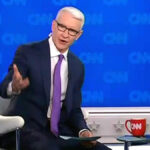
HORIST: The meaning of Christmas
As we approach the Christmas holiday, the issue of Church and state was bound to arise – and it most surely has.
The American Civil Liberties Union (ACLU) has written a complaint against Broward County (Florida) Commissioner Javier Souto for his annual greeting to his 10th District constituents – a population he has served for 24 years. In it he wrote:
We are approaching the happiest and most significant days on our calendar: Christmas and the Holidays … when we commemorate the birth of our King, Jesus, the Son of God.
I suspect Souto is a Christian who recognizes the purpose of this Christian religious holiday. Such a religious-based message is not unusual even in the public sector. There are also communications from politicians wishing Jews a Happy Hanukkah or messages to Muslims celebrating Ramadan.
One thing that cannot be secularized is the original and prevailing purpose of Christmas. Despite the best efforts of atheists, the secular media, the commercial retail industry and the extreme interpretations of many religious separation advocates, such as the ACLU, Christmas is a Christian religious holiday commemorating the birth of Jesus.
What many Americans may not realize is that it is also a declared national holiday – meaning it is officially celebrated by America as a nation. That has been the case since 1870 when the Congress and President Grant so declared.
The positive concepts of Christmas – love, family and goodwill to all – have always embraced the greater culture. Wishing a merry Christmas is not religious signally between devotees, but mostly a desire to extend to people of all beliefs an olive branch of peace and human harmony – an annual reminder of important common values regardless of individual religious beliefs.
It is not meant to disrespect or demean the beliefs of non-Christians or an attempt to recruit them to Christianity. Merry Christmas is often a greeting that many non-Christians extend to their Christian friends just as many Christians might wish Jews a Happy Hanukkah.
The effort to secularize Christmas is not new. Back in the 1950s, when America was even more devoutly Christian, there were efforts to distract society from the religious meaning of the holiday. It was an era when “Merry Xmas” gained a level of popularity, resulting in the “put Christ back into Christmas” movement.
So-called political correctness has gradually driven the iconic religious symbols of Christmas out of the commons – not only from public grounds but also from the commercial spaces. City halls and store windows alike have replaced the nativity scene, angels and crosses with Santa Claus, elves and non-religious ornaments – or have abandoned all historic imagery relating to the birth of Christ and Christmas traditions. A more recent secular movement has renamed the iconic tree as the “holiday tree.” Increasingly, the Christmas season is being redefined less appropriately as the “the holidays” without reference to its true history.
This movement away from the original and factual meaning of the holiday came home to me when I took my youngest son to see the famous Christmas windows at Chicago’s Marshall Field & Co more than a decade ago. A three-deep crowd moved from window to window. To my surprise, there were no displays depicting Christmas, but rather a dozen windows featuring Harry Potter.
So extreme has this trend become that when attending my son’s elementary school Christmas concert, the lyrics “We wish you a Merry Christmas …” were changed by the left-wing school principal to “We wish you a happy holiday …” The selection of songs included a wide range of non-Christian music – including Jewish, African and modern secular songs. What was in short supply were the traditional religious songs of Christmas. And this was a Christian celebration of Christmas featuring the students of a Christian school associated with Holy Name Cathedral – the very seat of the Catholic archdiocesan cardinal. How can such an event during such a season at such a location be oppressed by political correctness?
The secularization of Christmas is a mainstay on many college campuses. Students at the University of California (of course) are being advised to the holiday as celebrating a “special occasion” as opposed to a “specific holiday.” The school warned against parties that are “indirectly celebrating religious holidays.”
The State University of New York (another surprise?) instructed students to “create a winter theme with lights and color rather than religious icons” in their rooms or dormitories. Ohio University insisted that Christmas decorations be “secular in nature.” There is no such thing as a secular Christmas decoration.
Even at the Bible Belt University of Alabama, the school newspaper editorialized that “Bringing back the nativity scene is a slap in the face of the remaining regions thriving within America.” They even chastised the White House for displaying the nativity scene as an insult to all those who do not practice Christianity.
To understand how deeply the secularization of Christmas has become; when this author searched “Christmas images” on Bing to find the picture that appears at the top of this commentary, there were less than half a dozen (out of thousands of examples) that reflected the nativity of Jesus. There were, however, seemingly endless winter scenes, Santa Clauses, trees, candles and snowmen. Even the Teddy Bear outnumbered Christ.
While it is a widely accepted view that this separation of church and state that justifies driving Christmas from the public space is imposed by the Constitution, that is simply not historically accurate. In fact, the Constitution is quite broad in its defense of religious freedom. It proposes no limitations on religious expression. It states that “Congress shall make no law respecting the establishment of religion, or prohibiting the free exercise thereof.” And yet, we now have innumerable laws that limit or prohibit the “free exercise” of religion.
The Constitution also states that “no religious Test shall ever be required as a Qualification to any Office or public Trust under the United States” another admonition against any limitation. That’s it. No mention of any separation or limitation.
The concept of an impenetrable wall of separation was created by liberal activism on the federal courts without grounding in the Constitution. Decisions were based on an informal and unofficial 1802 letter from Thomas Jefferson to the Danbury (Connecticut) Baptist Association in which he expressed his personal opinion that the Constitutional language built “a wall of separation between Church & State.”
The modern interpretation of his meaning may well be a disservice to Jefferson. The contemporary court opinions and verdicts that suggest that the separation requires the removal of ALL religious expressions from the public forum and commons is quite contrary to the opinions of those signing the Constitution, including Jefferson, himself.
His “separation” language was simply paraphrasing the 1644 language of Roger Williams, the founder of the American Baptist Church, who opined that there existed “a hedge or wall of separation between the garden of the church and the wilderness of the world …” This was not a legal or constitutional opinion since the Constitution did not exist for another 145 years. It merely meant that the morality and comfort of the church was a safe haven from the wilds and wickedness of the world.
The constitutional language clearly expressed the Founders’ view that there shall not be an official national church – as was the case in England. They were in favor of free religious expression but opposed to religious oppression. The contemporary interpretation of separation of church and state, along with the divisive nature of political correctness, has created a social and civic environment of oppression of religious expression.
It was not their intent to drive all religion out of the public commons, but to make sure that all religions had equal access to these public spaces. City halls across the nation often use the public space to accommodate ethnic diversity in music, attire, dance and food as a means of sharing cultures – as both entertainment and educational events. Religion is the only diversity that modern separatists deem unsuitable to share.
It is so typical of the left to supplant reality with a politically correct but factually incorrect mythological view of the world. Christmas is the celebration of the birth of Christ – and has been for more than 2000 years. Attempts to transform it into some national orgy of commercialism and gluttony defies the true meaning. To remove the religious foundation of Christmas leaves the holiday devoid of any meaning at all. It becomes nothing more than celebration for the sake of celebration. In a way, it makes atheism the officially established religion of the state — the very thing specifically prohibited by the Constitution. However, these efforts will not dissuade Christians or even many non-Christians from celebrating the more significant meaning of this national holiday officially known as Christmas.
It may be only a coincidence, but that fact that we celebrate Christmas on the cusp of the new year suggests that our loving wishes are meant to be carried into the future year. The traditional wish is for both a Merry Christmas and a Happy New Year.
Even though I would not be considered a very religious person in the traditional sense, I am an originalist when it comes to Christmas. One does not have to harbor any denominational allegiance to celebrate an event that’s only purpose is to spread love, goodness and charity among all of humanity. It is a wish of mutual goodwill, not an imposition of religious dogma.
So, to my family, friends, acquaintances, readers and all good people of every belief, I wish you a
Very Merry Christmas and Happy New Year
Larry Horist is a conservative activist with an extensive background in public policy and political issues. Clients of his consulting firm have included such conservative icons as Steve Forbes and Milton Friedman, and he has served as a consultant to the White House under Presidents Nixon and Reagan. He has testified as an expert witness before numerous legislative bodies, including the U. S. Congress and lectured at Harvard University, Northwestern University, Florida Atlantic University, Knox College and Hope College. An award winning debater, his insightful and sometimes controversial commentaries appear frequently on the editorial pages of newspapers across the nation. He can be reached at lph@thomasandjoyce.com.























You of course are referring to Krusty Gnome?
This is how it usually beings - some libturds at some indoctrination camp put some nonsense out as "research" and…
What the Fox, Larry, just crickets? Comforting it is, there is a spot where I can say whatever is in…
Isn't a statute of limitation up on that one. This is litigious Trump going after his old demons he hasn't…
It is interesting how these studies get their 15 minutes of fame. Why didn’t The Dumpster use this to answer…